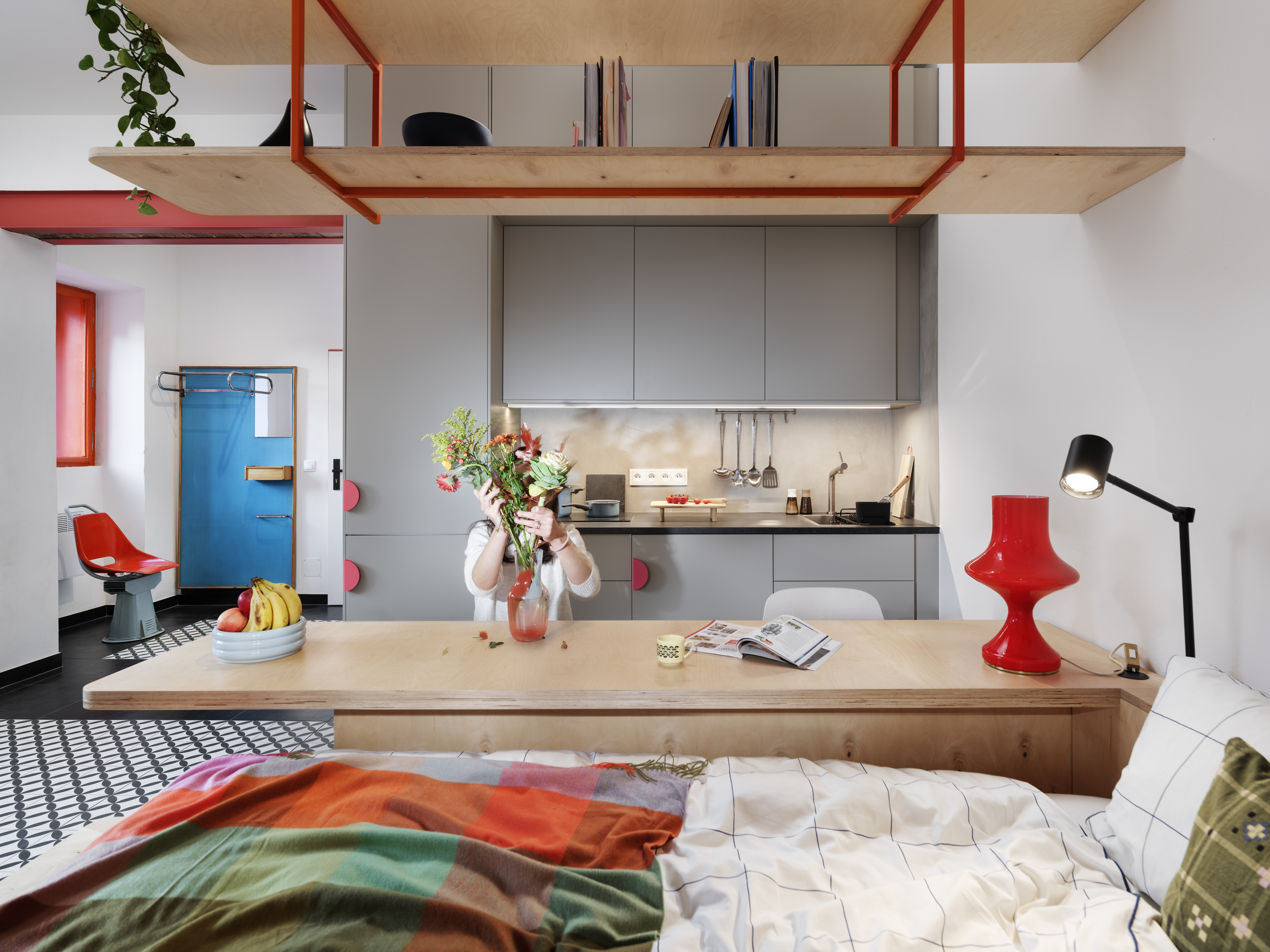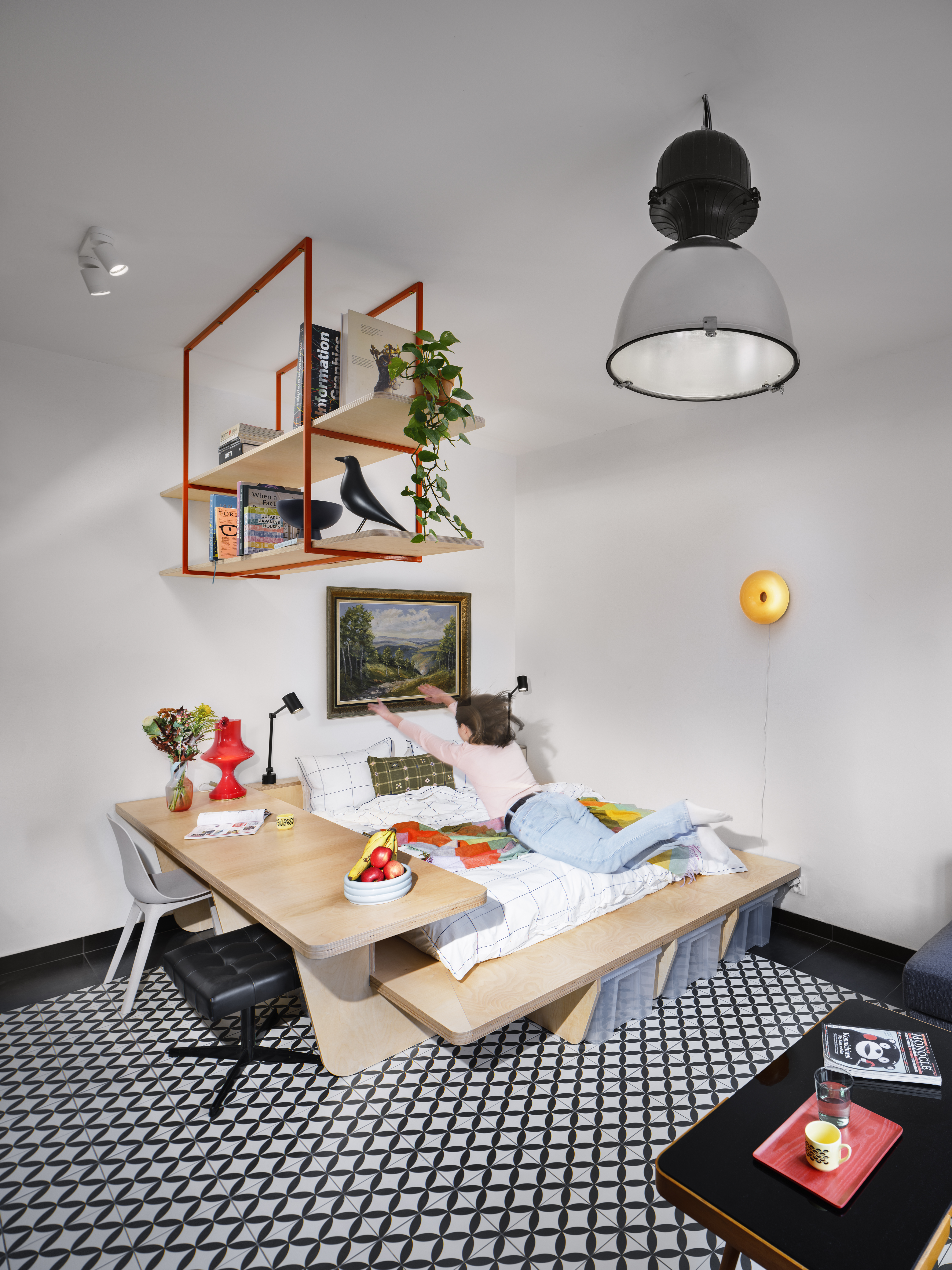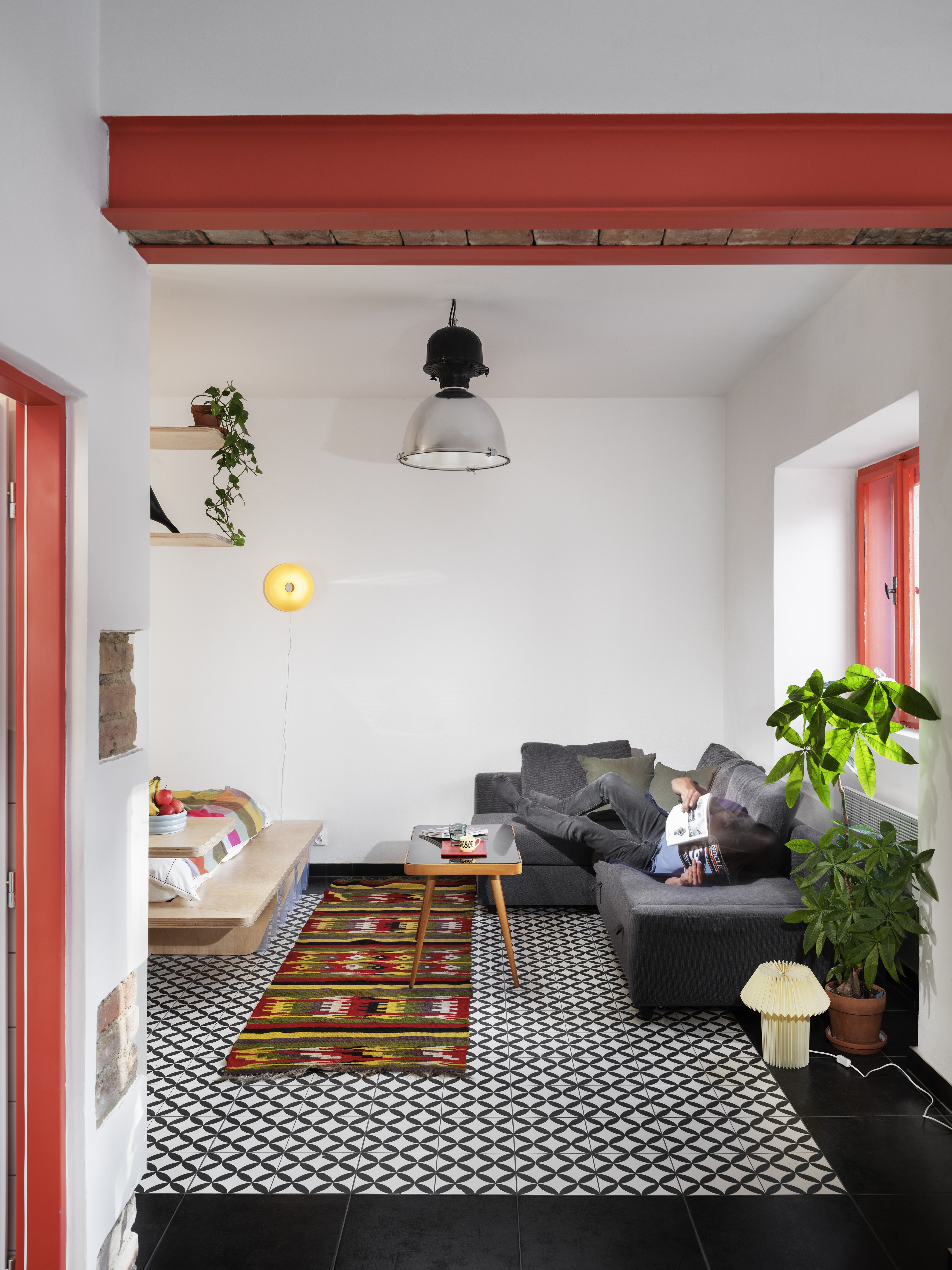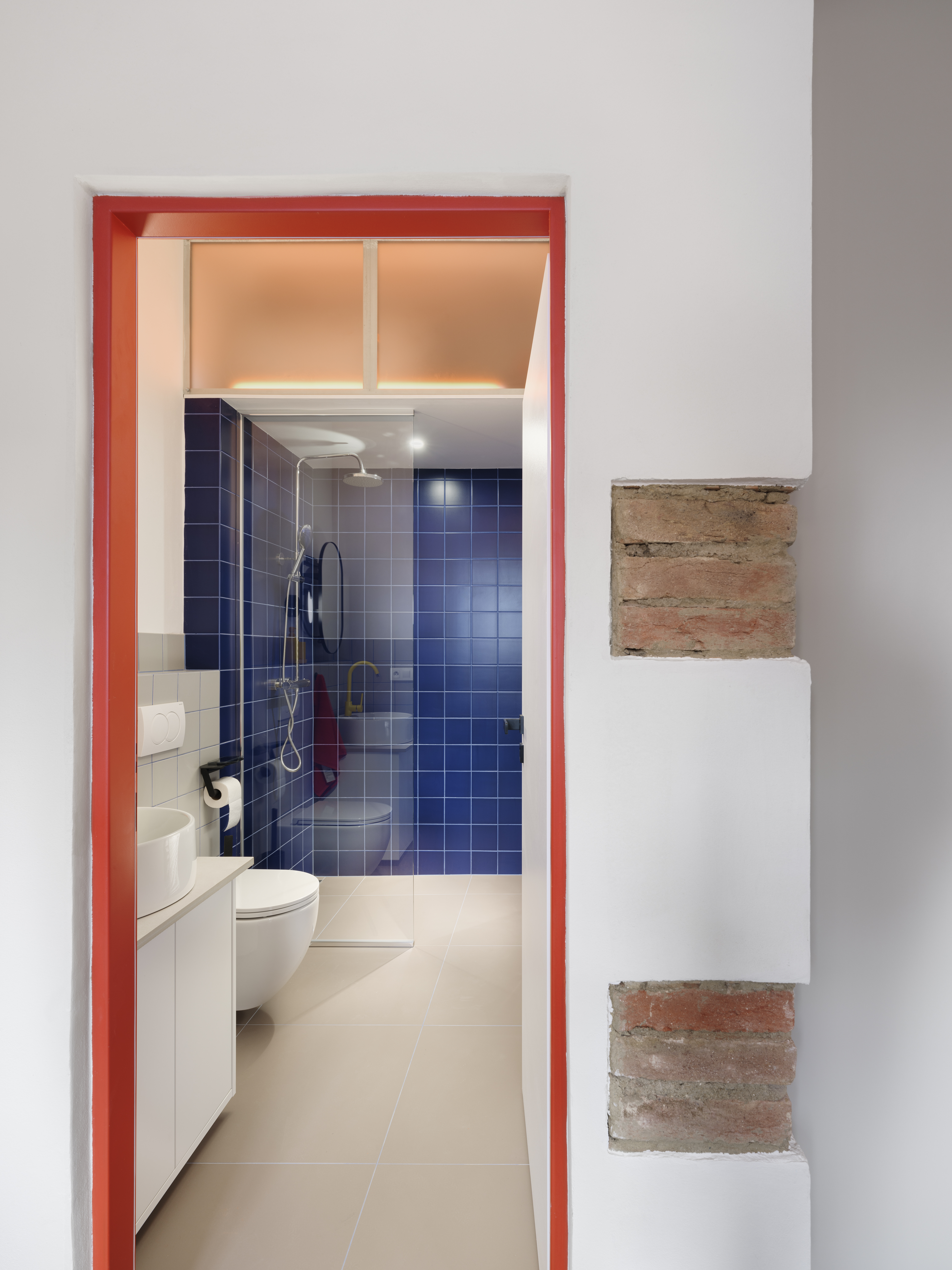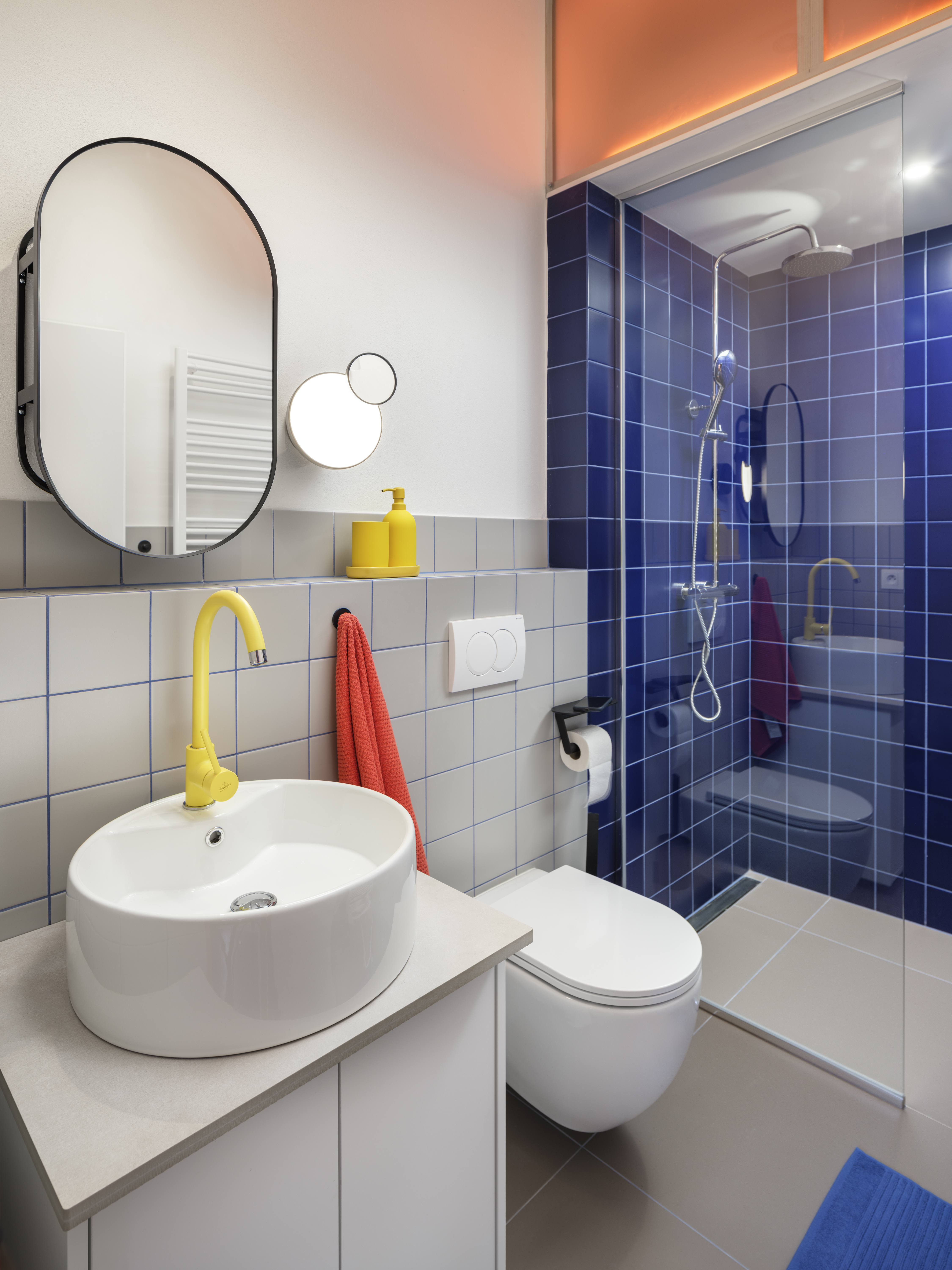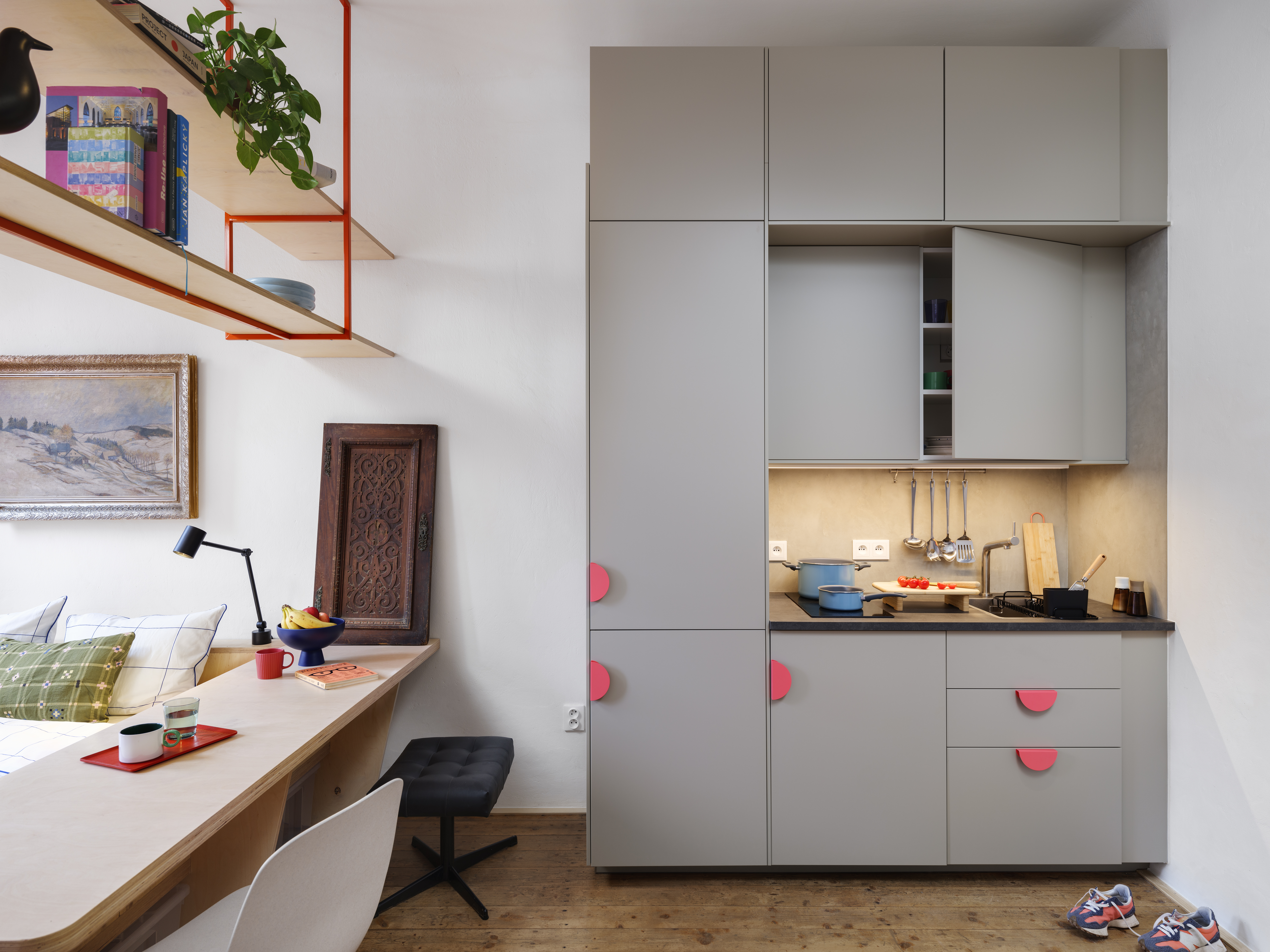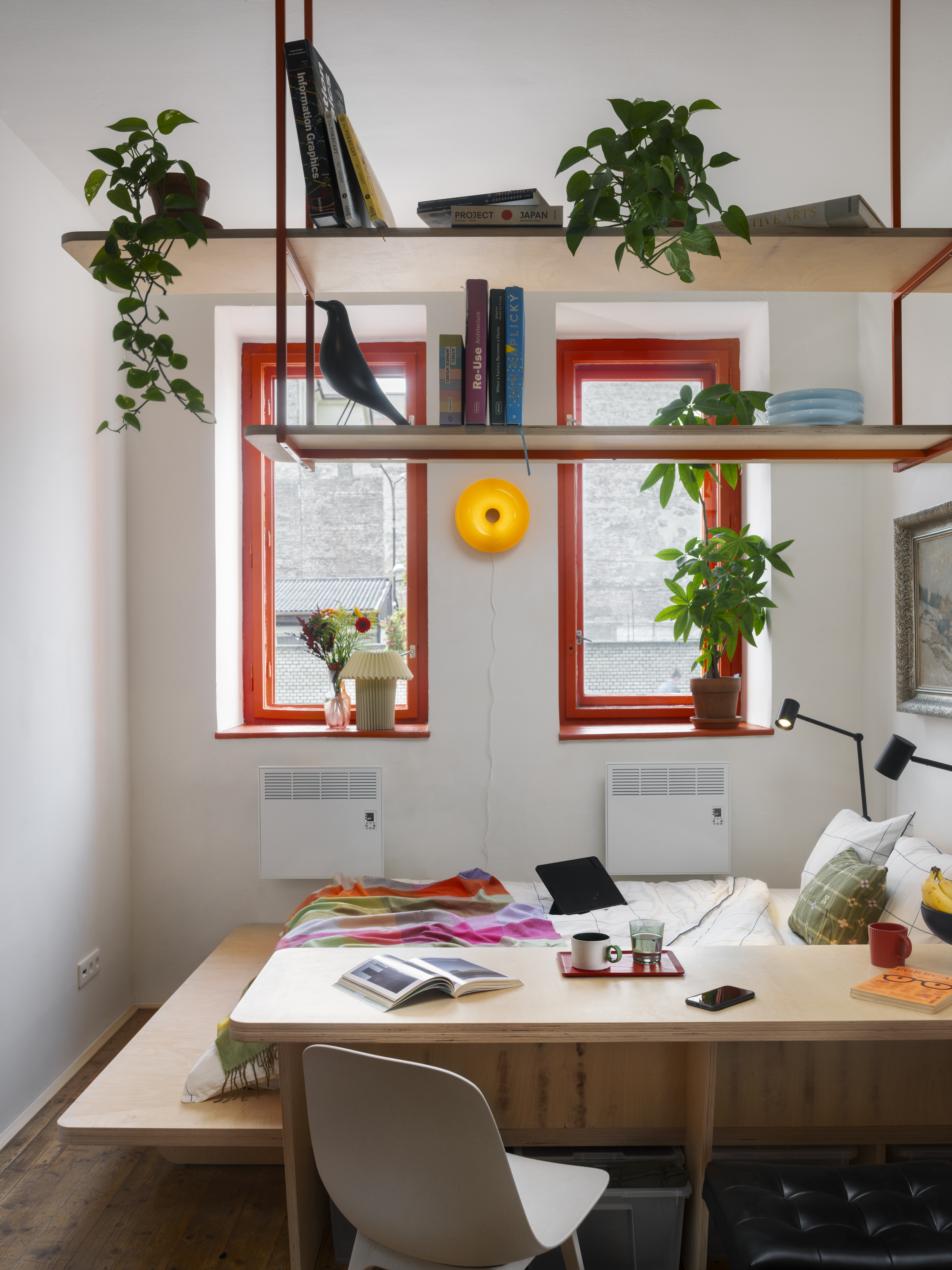Prioritising the places and people that need it the most
NOOX Living made easy
{Empty}
NOOX is a housing concept designed to address the growing challenges of homeownership, particularly in urban environments. Inspired by the idea of a “nook” - a small, cozy space that offers comfort and security - NOOX creates compact, thoughtfully designed living spaces that provide an immediate sense of home. As cities become denser and real estate prices continue to rise, NOOX offers an alternative to traditional housing models.
Czechia
Regional
South Moravia
Mainly urban
It refers to a physical transformation of the built environment (hard investment)
Yes
2024-12-02
No
No
Yes
Yes
Yes
As a representative of an organisation
NOOX is a self-initiated housing project by KOGAA, designed to address the growing crisis of affordable rental housing for young people in Brno. In line with the values of the New European Bauhaus, the project integrates affordability, functionality, and aesthetics, creating an accessible and well-designed living environment. NOOX offers fully equipped apartments with included services, eliminating the administrative burden of renting, such as utility transfers and internet setup. This approach simplifies city living and ensures that tenants can focus on their personal and professional growth.
By providing affordable, high-quality rental units, NOOX helps create a sustainable and inclusive urban environment. The project proves that good design does not have to be a luxury but can be made available to a wider audience. The apartments are designed with a minimalist yet playful aesthetic, balancing practicality and comfort while reflecting the identity of young urban dwellers.
Brno, like many European cities, faces skyrocketing housing prices, making homeownership increasingly unattainable for younger generations. NOOX directly responds to this challenge by offering an alternative: reasonably priced, well-located, and ready-to-move-in apartments. The project also enhances urban accessibility by placing tenants within walking distance of the city center, reducing reliance on cars and supporting a more sustainable lifestyle.
NOOX serves as a prototype that could be replicated in other cities facing similar housing crises. By rethinking the rental experience and integrating design, convenience, and community-oriented solutions, the project sets a new standard for modern, accessible housing.
By providing affordable, high-quality rental units, NOOX helps create a sustainable and inclusive urban environment. The project proves that good design does not have to be a luxury but can be made available to a wider audience. The apartments are designed with a minimalist yet playful aesthetic, balancing practicality and comfort while reflecting the identity of young urban dwellers.
Brno, like many European cities, faces skyrocketing housing prices, making homeownership increasingly unattainable for younger generations. NOOX directly responds to this challenge by offering an alternative: reasonably priced, well-located, and ready-to-move-in apartments. The project also enhances urban accessibility by placing tenants within walking distance of the city center, reducing reliance on cars and supporting a more sustainable lifestyle.
NOOX serves as a prototype that could be replicated in other cities facing similar housing crises. By rethinking the rental experience and integrating design, convenience, and community-oriented solutions, the project sets a new standard for modern, accessible housing.
Affordable housing
Urban living
Sustainable design
Move-in ready rental
Inclusive Architecture
NOOX embraces sustainability by revitalizing existing housing units instead of developing new buildings. The project transforms underutilized apartments in Brno into highly functional living spaces, reducing the environmental impact associated with new construction. Through thoughtful spatial reconfiguration, we maximized the usability of small-scale apartments, proving that good design can enhance both comfort and efficiency without expanding the footprint.
A key objective was to minimize waste by reusing as much of the original materials as possible. Instead of demolition, structural elements were renovated or repurposed, and any necessary material replacements followed reuse and recycling principles. Custom-built furniture was made from CNC-cut plywood panels, ensuring minimal material waste, while other furnishings were sourced from local retro and recycled furniture shops, further supporting the circular economy. By using pre-owned and upcycled elements, we not only reduce waste but also make sustainable design accessible and replicable. Project demonstrates that quality housing can be achieved without high costs or excessive resource consumption.
By prioritizing renovation over new construction and embracing resource-efficient solutions, the project sets an example for cities struggling with housing shortages and the environmental impact of real estate development.
A key objective was to minimize waste by reusing as much of the original materials as possible. Instead of demolition, structural elements were renovated or repurposed, and any necessary material replacements followed reuse and recycling principles. Custom-built furniture was made from CNC-cut plywood panels, ensuring minimal material waste, while other furnishings were sourced from local retro and recycled furniture shops, further supporting the circular economy. By using pre-owned and upcycled elements, we not only reduce waste but also make sustainable design accessible and replicable. Project demonstrates that quality housing can be achieved without high costs or excessive resource consumption.
By prioritizing renovation over new construction and embracing resource-efficient solutions, the project sets an example for cities struggling with housing shortages and the environmental impact of real estate development.
NOOX is a celebration of playful and fresh aesthetics, proving that compact living can be both functional and full of character. The design embraces bold colors, dynamic compositions, and smart spatial solutions to create an inviting and uplifting atmosphere.
A key element of the project’s aesthetic identity is its use of vibrant accents and unexpected details. The bright red structural beams, window frames, and furniture highlights bring energy into the space, while the geometric floor tiles and layered textures add a sense of rhythm and movement. Custom plywood furniture, designed for maximum flexibility, contributes to a cohesive yet lively interior where every piece plays a role in shaping the experience.
This aesthetic approach is not just about visual appeal - it directly provides the well-being of its users. The carefully curated colors and materials stimulate a sense of joy and creativity, turning the living space into an environment that feels both inspiring and personal. The playfulness of the design fosters a lighthearted atmosphere, making everyday routines more enjoyable and reducing the sense of constraint often associated with small-scale housing. By offering a visually stimulating yet harmonious setting, NOOX empowers its residents to feel at home, connected, and comfortable in their space.
The project enhances the quality of experience by prioritizing joy and engagement in daily living. The color contrasts, clever furniture integrations, and dynamic compositions invite curiosity and encourage a sense of belonging. Greenery further softens the interior, bringing a natural freshness to the space.
By merging functionality with bold aesthetics, project sets an example for how small-scale housing can feel both exciting and comfortable. It proves that even a compact rental unit can spark joy, stimulate creativity, and feel like a true home.
A key element of the project’s aesthetic identity is its use of vibrant accents and unexpected details. The bright red structural beams, window frames, and furniture highlights bring energy into the space, while the geometric floor tiles and layered textures add a sense of rhythm and movement. Custom plywood furniture, designed for maximum flexibility, contributes to a cohesive yet lively interior where every piece plays a role in shaping the experience.
This aesthetic approach is not just about visual appeal - it directly provides the well-being of its users. The carefully curated colors and materials stimulate a sense of joy and creativity, turning the living space into an environment that feels both inspiring and personal. The playfulness of the design fosters a lighthearted atmosphere, making everyday routines more enjoyable and reducing the sense of constraint often associated with small-scale housing. By offering a visually stimulating yet harmonious setting, NOOX empowers its residents to feel at home, connected, and comfortable in their space.
The project enhances the quality of experience by prioritizing joy and engagement in daily living. The color contrasts, clever furniture integrations, and dynamic compositions invite curiosity and encourage a sense of belonging. Greenery further softens the interior, bringing a natural freshness to the space.
By merging functionality with bold aesthetics, project sets an example for how small-scale housing can feel both exciting and comfortable. It proves that even a compact rental unit can spark joy, stimulate creativity, and feel like a true home.
NOOX redefines urban rental living by making quality design and comfortable housing more accessible to young people who often face challenges in finding affordable spaces. While traditionally, well-crafted interiors are associated with high costs, this project demonstrates that thoughtful design can be both inclusive and affordable. By repurposing existing apartments in central locations, using cost-effective materials, and applying smart spatial solutions, NOOX offers a high-quality living environment at a price that remains within reach for young professionals, students, and creatives.
A key aspect of inclusivity in NOOX is its commitment to urban living. In many European cities, the rising cost of rent is pushing young people to the outskirts, disconnecting them from cultural, social, and professional opportunities. NOOX challenges this trend by offering accessible housing directly in the heart of the city, ensuring that residents can fully engage with urban life without compromising on quality or affordability.
The flexibility of the design further contributes to its inclusivity. The multifunctional layout adapts to different lifestyles, allowing tenants to personalize their space according to their needs, whether they work from home, entertain friends, or simply seek a comfortable retreat.
Beyond affordability and adaptability, the project fosters a sense of community and belonging. The vibrant aesthetics and welcoming atmosphere encourage social interaction and create a feeling of home rather than a temporary rental.
By bridging the gap between affordability, quality, and adaptability, NOOX offers an inclusive housing model that can inspire future urban developments. It proves that rental housing does not have to be generic or isolating—it can be a place where people feel truly at home, connected to the city, and empowered to live in vibrant urban centers without financial barriers.
A key aspect of inclusivity in NOOX is its commitment to urban living. In many European cities, the rising cost of rent is pushing young people to the outskirts, disconnecting them from cultural, social, and professional opportunities. NOOX challenges this trend by offering accessible housing directly in the heart of the city, ensuring that residents can fully engage with urban life without compromising on quality or affordability.
The flexibility of the design further contributes to its inclusivity. The multifunctional layout adapts to different lifestyles, allowing tenants to personalize their space according to their needs, whether they work from home, entertain friends, or simply seek a comfortable retreat.
Beyond affordability and adaptability, the project fosters a sense of community and belonging. The vibrant aesthetics and welcoming atmosphere encourage social interaction and create a feeling of home rather than a temporary rental.
By bridging the gap between affordability, quality, and adaptability, NOOX offers an inclusive housing model that can inspire future urban developments. It proves that rental housing does not have to be generic or isolating—it can be a place where people feel truly at home, connected to the city, and empowered to live in vibrant urban centers without financial barriers.
From its inception, NOOX has been shaped by the needs and aspirations of its future residents. The project’s design principles were informed by direct dialogue with young professionals, students, and creatives, ensuring that the spaces respond to their expectations for affordability, functionality, and urban living. Instead of a top-down approach, NOOX was developed with an understanding of how young city dwellers live today—how they work, socialize, and use their homes dynamically.
To achieve this, the project team conducted interviews and informal consultations with potential residents, gathering insights into their daily routines, pain points, and housing priorities. Their feedback directly influenced key design decisions, such as integrating multifunctional furniture, prioritizing natural light, and creating adaptable layouts that accommodate various lifestyles.
Additionally, NOOX embraces a broader urban responsibility by activating existing housing stock rather than contributing to urban sprawl. The project aligns with city-led initiatives aimed at making housing more accessible in central areas, reinforcing the importance of compact, well-designed living spaces as a sustainable urban model.
Beyond the residents themselves, NOOX has sparked discussions within the local architectural and design community about new approaches to affordable housing and the role of compact living in future urban developments. The project demonstrates that well-crafted, livable spaces can be created at a reasonable cost without compromising on quality, sustainability, or aesthetics.
By involving future residents and aligning with broader urban housing strategies, NOOX serves as a model for participatory design in rental housing, ensuring that the needs of the community remain central to the process.
To achieve this, the project team conducted interviews and informal consultations with potential residents, gathering insights into their daily routines, pain points, and housing priorities. Their feedback directly influenced key design decisions, such as integrating multifunctional furniture, prioritizing natural light, and creating adaptable layouts that accommodate various lifestyles.
Additionally, NOOX embraces a broader urban responsibility by activating existing housing stock rather than contributing to urban sprawl. The project aligns with city-led initiatives aimed at making housing more accessible in central areas, reinforcing the importance of compact, well-designed living spaces as a sustainable urban model.
Beyond the residents themselves, NOOX has sparked discussions within the local architectural and design community about new approaches to affordable housing and the role of compact living in future urban developments. The project demonstrates that well-crafted, livable spaces can be created at a reasonable cost without compromising on quality, sustainability, or aesthetics.
By involving future residents and aligning with broader urban housing strategies, NOOX serves as a model for participatory design in rental housing, ensuring that the needs of the community remain central to the process.
NOOX stands out as an example of architects taking full ownership of the development process. Unlike conventional housing projects, which often rely on external investors or public funding, NOOX was initiated, designed, and fully financed by our architectural studio, KOGAA. By taking on the role of developers, we were able to preserve the integrity of our vision and ensure that the project remained committed to affordability, functionality, and high-quality design.
Rather than waiting for market-driven solutions, we took direct action to address the need for accessible urban living, demonstrating that architects can be proactive changemakers in the housing sector. This self-initiated approach allowed us to make design-driven decisions that prioritize long-term livability over short-term profit, ensuring that every square meter of the apartments is optimized for comfort and flexibility.
Although NOOX was developed independently, it engages with broader urban and housing policies by contributing to the revitalization of underutilized housing stock in city centers. The project aligns with municipal goals for densification and sustainable urban living, showcasing how small-scale initiatives can support larger city-wide objectives.
While not reliant on external stakeholders during its realization, the project serves as a case study for future collaborations between architects, policymakers, and urban planners who seek alternative housing models that respond to contemporary urban challenges.
By proving that architects can be both designers and developers, NOOX sets a precedent for how architectural studios can take a more active role in shaping the built environment—leading with design excellence, economic sustainability, and social responsibility.
Rather than waiting for market-driven solutions, we took direct action to address the need for accessible urban living, demonstrating that architects can be proactive changemakers in the housing sector. This self-initiated approach allowed us to make design-driven decisions that prioritize long-term livability over short-term profit, ensuring that every square meter of the apartments is optimized for comfort and flexibility.
Although NOOX was developed independently, it engages with broader urban and housing policies by contributing to the revitalization of underutilized housing stock in city centers. The project aligns with municipal goals for densification and sustainable urban living, showcasing how small-scale initiatives can support larger city-wide objectives.
While not reliant on external stakeholders during its realization, the project serves as a case study for future collaborations between architects, policymakers, and urban planners who seek alternative housing models that respond to contemporary urban challenges.
By proving that architects can be both designers and developers, NOOX sets a precedent for how architectural studios can take a more active role in shaping the built environment—leading with design excellence, economic sustainability, and social responsibility.
The NOOX project integrates principles from multiple disciplines to create an innovative housing solution tailored to the needs of young urban dwellers. Urban planning principles guided our approach to housing density and the efficient use of existing urban infrastructure, ensuring that the project contributes to a more vibrant and accessible city center.
Inspiration from international housing models, particularly from Denmark and other European contexts, helped shape our understanding of how compact, multifunctional living spaces can enhance quality of life. This knowledge, combined with our own architectural expertise, informed key design choices that prioritize adaptability, functionality, and spatial efficiency.
The project's economic and development model is equally significant. Rather than relying on external investors, we took full ownership of the process, managing both financing and implementation in-house. This approach allowed us to test a new, self-sufficient development strategy that challenges traditional real estate structures and explores alternative paths to creating affordable housing.
Lastly, sustainability and circular design principles played a crucial role. By repurposing an existing building, minimizing material waste, and opting for durable, timeless design choices, we have ensured that NOOX is both environmentally responsible and built to last.
This multidisciplinary mindset—rooted in extensive research, hands-on experience, and an understanding of global best practices—enabled us to create a housing model that is practical, sustainable, and socially relevant.
Inspiration from international housing models, particularly from Denmark and other European contexts, helped shape our understanding of how compact, multifunctional living spaces can enhance quality of life. This knowledge, combined with our own architectural expertise, informed key design choices that prioritize adaptability, functionality, and spatial efficiency.
The project's economic and development model is equally significant. Rather than relying on external investors, we took full ownership of the process, managing both financing and implementation in-house. This approach allowed us to test a new, self-sufficient development strategy that challenges traditional real estate structures and explores alternative paths to creating affordable housing.
Lastly, sustainability and circular design principles played a crucial role. By repurposing an existing building, minimizing material waste, and opting for durable, timeless design choices, we have ensured that NOOX is both environmentally responsible and built to last.
This multidisciplinary mindset—rooted in extensive research, hands-on experience, and an understanding of global best practices—enabled us to create a housing model that is practical, sustainable, and socially relevant.
Independent development model – Unlike traditional housing projects driven by investors, NOOX was fully initiated, financed, and developed by our architectural studio. This autonomy allowed us to prioritize design quality, affordability, and long-term usability over short-term financial returns.
A new urban housing prototype – By challenging both the standard real estate business model and conventional apartment typologies, NOOX presents a replicable solution for affordable, well-designed city living.
A hybrid between private living and community interaction – While mainstream rental housing often isolates individuals, NOOX encourages a sense of connection through shared spaces and a design that fosters interaction, taking inspiration from successful co-living models.
Flexible and space-efficient design – Instead of standard, rigid layouts, NOOX introduces smart spatial solutions like built-in multifunctional furniture and adaptable room configurations, making compact urban living more functional and comfortable.
Sustainability through reuse and longevity – Rather than demolishing and rebuilding, NOOX revitalizes existing housing stock, minimizes material waste, and incorporates re-used furniture and custom CNC-cut plywood elements to reduce environmental impact.
Affordability without compromise – NOOX demonstrates that high-quality, thoughtfully designed housing doesn’t have to be exclusive. By offering move-in-ready apartments with included services, it simplifies city living and reduces the financial burden of setting up a new home.
A new urban housing prototype – By challenging both the standard real estate business model and conventional apartment typologies, NOOX presents a replicable solution for affordable, well-designed city living.
A hybrid between private living and community interaction – While mainstream rental housing often isolates individuals, NOOX encourages a sense of connection through shared spaces and a design that fosters interaction, taking inspiration from successful co-living models.
Flexible and space-efficient design – Instead of standard, rigid layouts, NOOX introduces smart spatial solutions like built-in multifunctional furniture and adaptable room configurations, making compact urban living more functional and comfortable.
Sustainability through reuse and longevity – Rather than demolishing and rebuilding, NOOX revitalizes existing housing stock, minimizes material waste, and incorporates re-used furniture and custom CNC-cut plywood elements to reduce environmental impact.
Affordability without compromise – NOOX demonstrates that high-quality, thoughtfully designed housing doesn’t have to be exclusive. By offering move-in-ready apartments with included services, it simplifies city living and reduces the financial burden of setting up a new home.
Architect-Led Development – Instead of following the conventional path of investor-driven real estate, we took full control of the project from design to execution, ensuring that architectural quality and affordability remained the core priorities.
User-Centered Design & Research – We studied successful housing models abroad (e.g., in Denmark) and analyzed the needs of young urban dwellers to create a housing concept that balances privacy, flexibility, and ease of living.
All-Inclusive Living Concept – Unlike standard rentals where tenants must handle contracts for utilities and internet, NOOX bundles everything into a single service, making the move-in process seamless and stress-free.
Urban Integration – The project prioritizes central city living by placing tenants in walkable, well-connected areas, reducing reliance on cars and promoting a sustainable urban lifestyle.
Maximizing Existing Space – The project focused on reconfiguring existing layouts to optimize small spaces through built-in solutions, multifunctional furniture, and efficient storage without sacrificing aesthetics or comfort.
User-Centered Design & Research – We studied successful housing models abroad (e.g., in Denmark) and analyzed the needs of young urban dwellers to create a housing concept that balances privacy, flexibility, and ease of living.
All-Inclusive Living Concept – Unlike standard rentals where tenants must handle contracts for utilities and internet, NOOX bundles everything into a single service, making the move-in process seamless and stress-free.
Urban Integration – The project prioritizes central city living by placing tenants in walkable, well-connected areas, reducing reliance on cars and promoting a sustainable urban lifestyle.
Maximizing Existing Space – The project focused on reconfiguring existing layouts to optimize small spaces through built-in solutions, multifunctional furniture, and efficient storage without sacrificing aesthetics or comfort.
The NOOX project presents a highly replicable model for addressing housing challenges in urban environments. By focusing on the renovation of existing apartments rather than new construction, it offers a strategy that can be applied in various cities where the demand for affordable, well-designed housing exceeds supply. The approach is particularly relevant for municipalities managing public housing stock, providing a blueprint for how underutilized properties can be transformed into high-quality rental units with minimal investment and maximum efficiency.
At its core, NOOX is a demonstration of how architects can play a more active role in housing development, taking on responsibilities traditionally held by developers. This architect-led renewal process ensures that design quality, sustainability, and user experience are prioritized, resulting in spaces that are not only functional but also aesthetically engaging.
NOOX rethinks the rental experience by simplifying the process for tenants. The all-inclusive model, where utilities, internet, and maintenance are covered in a single fee, reduces barriers to access and makes urban living more approachable for young professionals. This strategy can be adopted by both private landlords and public institutions looking to create housing solutions that are easy to manage and attractive to renters.
Perhaps most importantly, NOOX offers a vision of how cities can support younger generations in securing their first independent housing. Whether applied to municipal rental programs, university housing, or cooperative living models, its principles of affordability, flexibility, and design-driven quality can be adapted to different target groups, making it a valuable precedent for future urban housing solutions.
At its core, NOOX is a demonstration of how architects can play a more active role in housing development, taking on responsibilities traditionally held by developers. This architect-led renewal process ensures that design quality, sustainability, and user experience are prioritized, resulting in spaces that are not only functional but also aesthetically engaging.
NOOX rethinks the rental experience by simplifying the process for tenants. The all-inclusive model, where utilities, internet, and maintenance are covered in a single fee, reduces barriers to access and makes urban living more approachable for young professionals. This strategy can be adopted by both private landlords and public institutions looking to create housing solutions that are easy to manage and attractive to renters.
Perhaps most importantly, NOOX offers a vision of how cities can support younger generations in securing their first independent housing. Whether applied to municipal rental programs, university housing, or cooperative living models, its principles of affordability, flexibility, and design-driven quality can be adapted to different target groups, making it a valuable precedent for future urban housing solutions.
One of the most critical global issues is the housing crisis, where rapidly rising rents and property prices make homeownership unattainable for younger generations. NOOX directly addresses this challenge by providing an affordable, move-in-ready rental model that eliminates the typical financial and administrative burdens of securing housing. This approach can be replicated in other cities facing similar affordability concerns.
Another global challenge is urban density and the need for more efficient land and space use. Many cities struggle with a shortage of well-designed, compact living spaces that cater to young professionals and mobile workers. NOOX maximizes the potential of existing housing stock by renovating small apartments with clever space optimization strategies, making urban living more accessible without requiring additional land use or new construction.
The project also responds to the climate crisis and the construction industry’s environmental impact. By reusing and upgrading existing structures instead of building new developments, NOOX significantly reduces the carbon footprint associated with new construction. It promotes sustainable renovation practices, including material reuse, minimal waste strategies, and locally sourced, low-impact furnishings, aligning with circular economy principles.
Lastly, project contributes to the global shift toward more flexible and community-oriented living models. As cities worldwide grapple with evolving work and lifestyle trends—such as remote work, increased mobility, and changing family structures—there is a growing need for affordable, adaptable, and well-located housing that meets these new demands. By offering a turn-key solution with a seamless rental experience and an inclusive, design-focused environment, NOOX provides a replicable model for urban housing that prioritizes accessibility, sustainability, and quality of life.
Another global challenge is urban density and the need for more efficient land and space use. Many cities struggle with a shortage of well-designed, compact living spaces that cater to young professionals and mobile workers. NOOX maximizes the potential of existing housing stock by renovating small apartments with clever space optimization strategies, making urban living more accessible without requiring additional land use or new construction.
The project also responds to the climate crisis and the construction industry’s environmental impact. By reusing and upgrading existing structures instead of building new developments, NOOX significantly reduces the carbon footprint associated with new construction. It promotes sustainable renovation practices, including material reuse, minimal waste strategies, and locally sourced, low-impact furnishings, aligning with circular economy principles.
Lastly, project contributes to the global shift toward more flexible and community-oriented living models. As cities worldwide grapple with evolving work and lifestyle trends—such as remote work, increased mobility, and changing family structures—there is a growing need for affordable, adaptable, and well-located housing that meets these new demands. By offering a turn-key solution with a seamless rental experience and an inclusive, design-focused environment, NOOX provides a replicable model for urban housing that prioritizes accessibility, sustainability, and quality of life.
The NOOX project was realized at the end of 2024, and we are currently welcoming our first tenants, while finalizing the last unit. Despite being in its early stages, the project has already generated significant interest from potential renters as well as the media, highlighting its relevance and the demand for alternative housing solutions.
One of the immediate outcomes has been the successful validation of our housing model, demonstrating that there is a strong need for fully equipped, well-designed, and hassle-free rentals in urban centers. The initial feedback from tenants suggests that the combination of thoughtful design, affordability, and seamless services significantly enhances their living experience, confirming that our concept resonates with the target group.
Beyond direct beneficiaries, the project has sparked conversations around new approaches to urban housing, the role of architects as proactive developers, and how existing housing stock can be reimagined to meet contemporary needs. As media interest grows, NOOX is positioning itself as an inspirational and scalable model for cities looking to provide accessible housing for young people.
While long-term impact data is still being gathered, early indicators suggest that NOOX is not just filling a housing gap but also influencing the dialogue on urban living, affordability, and the role of design in shaping better housing solutions. With its strong replicability potential, the project has the capacity to inspire both public and private stakeholders to explore similar models in other cities.
One of the immediate outcomes has been the successful validation of our housing model, demonstrating that there is a strong need for fully equipped, well-designed, and hassle-free rentals in urban centers. The initial feedback from tenants suggests that the combination of thoughtful design, affordability, and seamless services significantly enhances their living experience, confirming that our concept resonates with the target group.
Beyond direct beneficiaries, the project has sparked conversations around new approaches to urban housing, the role of architects as proactive developers, and how existing housing stock can be reimagined to meet contemporary needs. As media interest grows, NOOX is positioning itself as an inspirational and scalable model for cities looking to provide accessible housing for young people.
While long-term impact data is still being gathered, early indicators suggest that NOOX is not just filling a housing gap but also influencing the dialogue on urban living, affordability, and the role of design in shaping better housing solutions. With its strong replicability potential, the project has the capacity to inspire both public and private stakeholders to explore similar models in other cities.

